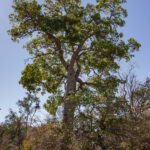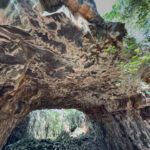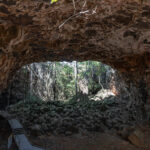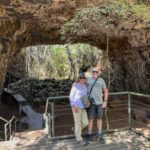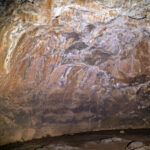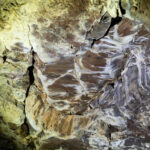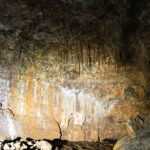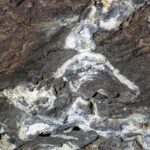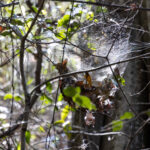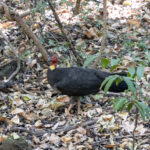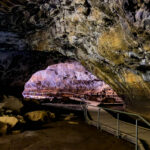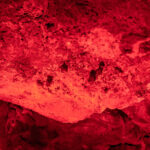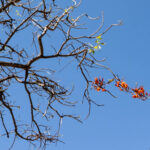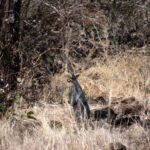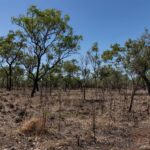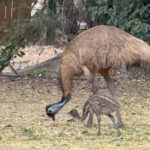Sunday, 20 October 2024
This morning, I popped into the bathroom for my shower, switching on the light and the fan on my way in because the switches are on the outside wall, closed the door and put the bathmat down on the floor. Blimey, talk about suction, the bathmat was undulating like a flying carpet with the force of the air being sucked through the bathroom. Bernie thinks this had something to do with the drain point in the floor?? Maybe because I moved the mat off the floor drainage point and the bathmat settled down.
The next challenge was the shower head. Magnificent, huge, square rain shower head. The only problem is, if the kettle is anything to go by, Mount Surprise has a scale problem. The effect this has had on the shower head is that virtually no water comes out of the shower head through the holes in the bottom. The water seems to bubble up through the top of the shower head and dribble down the sides!! Oh well, it was hot and wet so sort of worked.
After our showers and breakfast in our cabin, we were ready by 8.00am to be bussed out to Undara Volcanic National Park. We were met by our guide, Maigread. That is how it was spelled on her name badge, but when she introduced herself, she told us she has a funny Irish name that is pronounced like ‘parade’ but starting with an M. Good to know because I had looked at her name tag – I like to record our guide’s names in the travel diary – and I had no idea how I would pronounce that collection of letters!
Maigread drove us about 50 kilometres along the Gulf Development Road and Undara Road into the national park. We stopped at the resort to use the toilets and pick up two more passengers who are camping at the Undara Discovery Resort. It’s pretty basic out there at the moment with only campsites available and the restaurant and bar has closed for the season. Even though it’s a bit basic at Mount Surprise we are not in tents, we have air-conditioned cabins AND the roadhouse is open for lunch and the pub is open for dinner. All our basic needs are being met.
The Undara Lava Tubes are considered to be a world-class geological phenomenon. They are so significant they have attracted the attention of David Attenborough (who has visited twice) and NASA which was very interested in similarities that the landscape has with the moon.
Maigread drove us along past the 100 Mile Swap which is now completely dry. Until a few weeks ago there was still some water in the swamp. However, as it dries out grass shoot emerge and the macropods – kangaroos, two species of wallaby and two species of wallaroo – are enjoying the grazing.
After parking the bus and unloading us, Maigread explained that once the landscape was covered in rainforest-type vegetation. However, as the area became dryer the vegetation gradually changed to an open, grassy eucalypt (Savannah) woodland. But the amazing thing is that in places where sections of lava tube have collapsed a cool, damp environment has been created that has preserved pockets of dry rainforest trees and vines.
Before leading us down to the first cave Maigread introduced us to the broad-leafed bottle tree which is NOT a boab tree. Those are found in Western Australia and can also be found in Africa. The brachychiton australis is Queensland’s own bottle tree. While we were above ground, so to speak, the drone of cicadas was LOUD, and it was HOT. It was astonishing to start down the stairs into the tunnel collapse. First, the walls of the collapse sheltered us from the cicada’s relentless assault on our eardrums and then the temperature started to drop and instead of seeing grasses and eucalypts we were surrounded by vines and fig trees, and we could hear birds calling from the treetops and forest floor.
Our first stop was at The Archway. An incredible arch has been formed here where the tunnel has collapsed on either side of a section of lava tube that has been left behind. We had no idea that we were going to see a feature like this, so we were already impressed. Maigread explained to us that when this area was volcanic, about 190,000 years ago, the lava from the volcano flowed along existing watercourses. The top of the flow cooled more quickly than the section inside the watercourses and this difference in cooling caused the tunnels to form. There was a lot more about the geology but that was the gist of it. And the tunnels are extensive. It’s estimated that the longest tunnel runs for about 160 kilometres but only sections where collapses have occurred can be explored so there is some conjecture about the full extent of the tunnels.
We ventured into the smaller of two caves that are covered on this tour, Ewamian Cave. It is believed that this cave formed when a lava flow met an impenetrable section of granite which forced it to veer left into what is now known as Ewamian Cave. The cave is named for the traditional owners of this landscape the Ewamian (pron You-a-min) Aboriginal people although there is no evidence that they ever inhabited these caves. They have no oral history of the caves, and no evidence has been found that the caves were ever occupied. Maigread said the atmosphere in the caves tends to be high in carbon dioxide which is likely to be why they were not considered desirable to inhabit. Although there was no Aboriginal rock art inside the cave, Maigread pointed out several artistic features created by nature.
From the smaller cave we walked around to Stephenson Cave which Maigread described as being cathedral-like in its proportions. As we walked along the boardwalk, the hammock spider’s webs were pointed out to us. These webs were everywhere and in a couple we could see the spider sitting inside the hammock waiting for lunch. We also saw a bush turkey scrabbling around in the undergrowth, but most of the birds we only heard their calls. Arriving at the cave we could see straight away that it is much larger and apparently is considered by David Attenborough to be the largest cave of its kind in the world.
This larger cave is inhabited by little bent-wing microbats. There are only a few bats remaining in the cave at the moment because most have moved to the nursery cave because it is breeding season. Originally when we booked at Undara Discovery Resort we were going to do the sunset tour to the nursery cave BUT with the early closure of the resort that tour has already finished for the season. When Maigread mentioned that all the neighbourhood snakes literally hang out (in the trees) at the entrance to pick off microbats for dinner I was just as happy that we arrived out of season for that tour!!! Ugh. Even with few bats about Maigread managed to spotlight some with a bat friendly infra-red torch for us.
These caves have certainly been different from your more common limestone cave, and we’ve been in a few of those over the years. The basalt rock and the endemic minerals makes these caves a very different colour to start with. The rock is mostly red but had cream, pink and even purple highlights. The other huge difference – none of the stalactites or stalagmites that characterize a limestone cave. The closest similarity might be the flow stone effect that you get in a limestone cave being a little bit like the drip and dribble (the actual technical term!) effect in these caves. This is a feature that was set in stone as the lava dripped and dribbled down the walls as the lava cooled.
It was time to return to the bus with the temperature rising with every step we took away from the cave and then up the stairs. Maigread joked several times that her ‘office’ is not a bad one to have. Personally, I’m happy to have worked in an office that didn’t have snakes in it! Today was the first place that we’ve visited since Cobar where the legless reptiles have been specifically mentioned. Once again, I was wearing long pants and sturdy walking shoes to reduce the chance of a fatal snake bite. Intellectually I know that it’s statistically unlikely that I will die from a snakebite, but I remain irrationally afraid of being bitten by one of Australia’s deadliest inhabitants!
We made another toilet stop back at the park before Maigread ferried us the 50 odd kilometres back to Mount Surprise. Ha, ha, this is another section of road that we are going to travel several times because we’ll be heading out this way again tomorrow as we travel to the Kennedy Developmental Road and then south to Charters Towers.
Back at our cabins we changed into cooler clothes and shoes and then ventured out to the BP Roadhouse again for lunch. It may be boring to eat at the same place two days in a row – and eat the same food! – but to be honest we are just glad that something is open on a Sunday. The old dear running the place looks like she’s 100, not out (OK, at least in her 80s?) and it all looks to be a bit of a struggle for her, so we were happy to support her business and keep her till ticking over. With the upgrades going on with the bowsers we wonder if she’s fixing to sell or if BP is doing the upgrade to try to attract new blood to manage this outback roadhouse?? Travellers need these places but nearly all of them are so old and rundown that you wonder how they survive.
Nothing to do all afternoon except hang out by the pool. While we were out there, we had a forest kingfisher sitting on the fence for a while occasionally skimming over the pool catching insects. Another couple arriving poolside alerted us to the fact that there was an Emu and four chicks wandering around so I levered myself out of the sun lounge to take a couple of photos. Of course, we only had Bernie’s mobile out by the pool I had decided not to take my DSLR with me. First rule of photography – always have your camera with you!
We were heading out to dinner and for the first time all holiday I didn’t check with Bernie if he had the key on him and I closed the door. Of course, because I didn’t double check, the key was in the room. We wandered out to reception to get the caretaker’s mobile number from the notice on the shutter. Ha, ha, ha, she laughed I’ll be there in a minute to let you in. Phew, glad that was easily sorted but I’m sure we won’t be the first and we won’t be the last.
Off to the pub again for dinner tonight. Nearly every pub in Queensland has listed crumbed steak on the menu. Bernie and I were talking about it on the way back in the bus this morning and we had both independently decided that we were going to try the crumbed steak for dinner tonight because it has to be a beef schnitzel, doesn’t it? We were discussing it at the bar before ordering it and we asked if it’s like a schnitzel. We were told, no, it’s a crumbed steak. Honestly, we’ll never know if we don’t order one so Bernie ordered his with chips, salad and gravy and I ordered mine with veggies, potatoes and gravy. Our verdict? It’s a beef schnitzel. Obviously, it’s a Queensland thing to call it a crumbed steak. Just one of those weird naming conventions like pot/schooner or potato cake/potato scallop.


